MIBS 2017: Furuno standalone 1815 radar, DFF-3D multimodal sonar & more
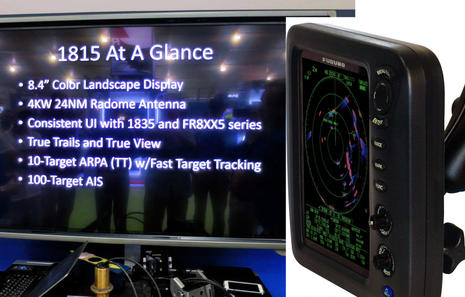 While Furuno USA had a lot to show off at the Miami Boat Show, let's start with the new 1815 standalone radar. Recent Panbo entries about Raymarine's sleek new Axiom Series multifunction displays and Navico's ambitious systems integration strategy drew some keep-it-simple skeptics. But it is still possible to find single function marine electronics if that's your preference, and the 1815 may be an excellent small radar choice packing a whole lot of performance for the price...
While Furuno USA had a lot to show off at the Miami Boat Show, let's start with the new 1815 standalone radar. Recent Panbo entries about Raymarine's sleek new Axiom Series multifunction displays and Navico's ambitious systems integration strategy drew some keep-it-simple skeptics. But it is still possible to find single function marine electronics if that's your preference, and the 1815 may be an excellent small radar choice packing a whole lot of performance for the price...
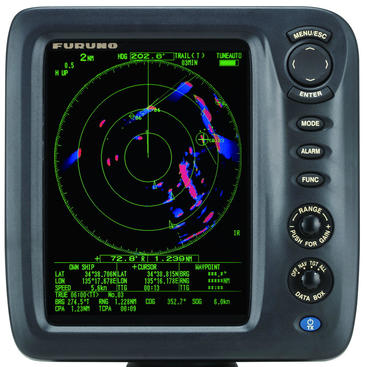 The Furuno 1815 radar retailing for $2,500 includes the 8.4-inch color portrait display and control head seen above, along with a 19-inch 4kW radome. And those bright blue "True Trails" seen on the screen are a very useful feature not available on most recreational radars at any price. True echo trails, as opposed to the much more commonly seen relative trails, means that the trails show actual target motion regardless of your boat's motion. The direction of the true trail indicates the target vessel's heading over the ground while its length suggests its speed.
The Furuno 1815 radar retailing for $2,500 includes the 8.4-inch color portrait display and control head seen above, along with a 19-inch 4kW radome. And those bright blue "True Trails" seen on the screen are a very useful feature not available on most recreational radars at any price. True echo trails, as opposed to the much more commonly seen relative trails, means that the trails show actual target motion regardless of your boat's motion. The direction of the true trail indicates the target vessel's heading over the ground while its length suggests its speed.
Incidentally, some other recreational radars can show true trails but usually as only one aspect of a True Motion view in which your vessel moves across the screen instead of the targets, trails, etc. moving along with your vessel (more detailed discussion here). Some users are confused by true motion, and, to the best of my knowledge, only Furuno offers true trails regardless of viewing mode. Moreover, the 1815 also offers an unusual True View mode, which is a lot like the simple and popular Head Up mode, except that all the target imaging responds to your boat's actual heading instead of just where the bow is pointed.
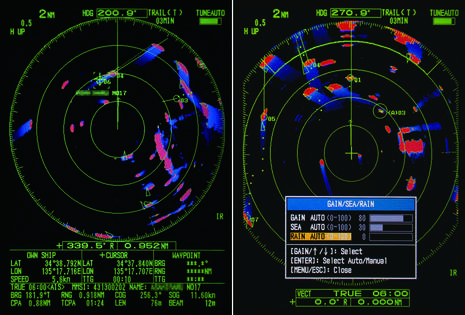 Both of these 1815 screens show True Trails at work (in Head Up mode) as well as the 1815's ability to plot AIS targets and to track its own targets. I was intrigued to see the latter described in Miami as "10-target ARPA (TT) with Fast Target Tracking", because FTT is also what Furuno calls the phenomenal ARPA tracking I've seen from their DRS4D-NXT radome.
Both of these 1815 screens show True Trails at work (in Head Up mode) as well as the 1815's ability to plot AIS targets and to track its own targets. I was intrigued to see the latter described in Miami as "10-target ARPA (TT) with Fast Target Tracking", because FTT is also what Furuno calls the phenomenal ARPA tracking I've seen from their DRS4D-NXT radome.
For instance, in my experience Fast Target Tracking would mean that target #3 on the left screen above was intelligently and automatically selected, because it's moving my way, and, moreover, that its true heading and speed were calculated very quickly and accurately. With the NXT, I also see very fast results for targets I select manually, which I'm usually doing with a fingertip on the test NavNet TZT2 12-inch MFD, and then a similar tap pops up the target's heading and speed info.
On the 1815 display that sort of easy finger work will have to be done with the cursor control and Enter button, and while the NXT radar can handle 100 automatic and manual targets at once, the 1815 is limited to 10. And it turns out there's more Fast Target Tracking limitation in the 1815 than that.
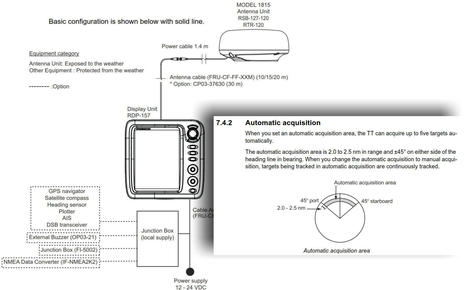 As you can see in the 1815 manual inset above, automatic target acquisition is limited to a fixed 90° guard zone two miles ahead of your vessel. That's like the first Furuno NavNet ARPA I experienced, except that you could customize the zone, and the amazing NXT acquires whatever targets it thinks are important anywhere around you, no zone needed. Tentative 1815 owners should understand these limitations, but complaints aren't easily justified. I'll bet that few readers have any sort of automatic radar plotting aid (ARPA) unless they already own a fairly modern Furuno.
As you can see in the 1815 manual inset above, automatic target acquisition is limited to a fixed 90° guard zone two miles ahead of your vessel. That's like the first Furuno NavNet ARPA I experienced, except that you could customize the zone, and the amazing NXT acquires whatever targets it thinks are important anywhere around you, no zone needed. Tentative 1815 owners should understand these limitations, but complaints aren't easily justified. I'll bet that few readers have any sort of automatic radar plotting aid (ARPA) unless they already own a fairly modern Furuno.
Actually, the ARPA situation is rather remarkable given how competitive marine electronics is. For years Furuno has been the only manufacturer I know of offering it in recreational radars, even though this valuable feature seems high on the list of every radar product manager I know. But recently Furuno has apparently improved the speed and accuracy of its MARPA and still unmatched ARPA with Fast Target Tracking algorithms, and absolutely supercharged them with the Doppler assistance available in the solid-state NXT.
So even the 1815's limited ARPA/MARPA FTT -- maximum five targets each -- is impressive. But tentative owners should also realize that getting the 1815's advanced features requires NMEA 0183 interfacing with Heading, GPS, and AIS sources, and a plotter data interface can be very useful, too (chart overlay is not possible, but you can at least have a shared go-to waypoint that helps orient your radar and plotter views). In other words, a full-featured 1815 installation won't be completely standalone, as suggested in diagram above. Also, it's almost invariably smart shopping to study the product manual as well as the brochure.
X-Class 12 & 25 kW
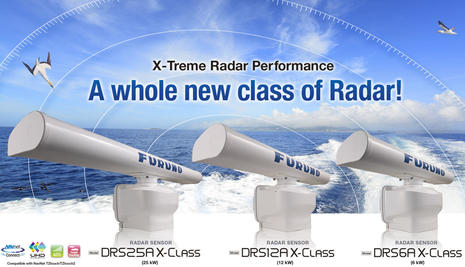 In Miami Furuno also added 12 and 25 kW versions to its X-Class family of NavNet open array radars. They're modular -- so, for instance, that original $5,395 DRS6AX with a 3.5-foot antenna could be alternately rigged with 4- or 6-footers for a maximum retail total of $6,240 -- and you have to delve into both TZtouch and TZtouch2 operator manuals to see some of the possible radar display features (which differ between the two MFD series).
In Miami Furuno also added 12 and 25 kW versions to its X-Class family of NavNet open array radars. They're modular -- so, for instance, that original $5,395 DRS6AX with a 3.5-foot antenna could be alternately rigged with 4- or 6-footers for a maximum retail total of $6,240 -- and you have to delve into both TZtouch and TZtouch2 operator manuals to see some of the possible radar display features (which differ between the two MFD series).
Actually, right now only the TZT2 software 4.01 literature will tell you about that Echo Trail, and Average functions are now available (which Fred Khedouri missed in his early TZT2 review). Also, both TZT and TZT2 support True Trails, but I'm waiting on the exact parameters of X-Class automatic and manual Fast Target Tracking (hopefully just until tomorrow).
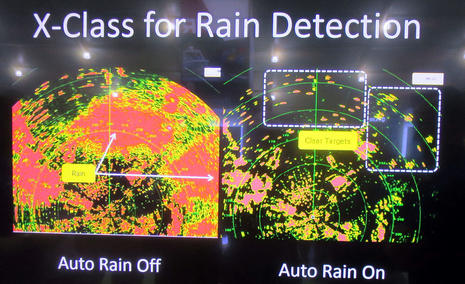 A lot of features like automatic and effective bird mode are highlighted on the dedicated X-Class radar site and in the X-Class video. Adding to the high performance image roster is the Miami presentation screen above, which seems to indicate very effective auto rain filtering. It's interesting that Furuno, which has already developed commercial FAR-3000 solid-state S-band radar plus the remarkable NXT radome, is so far sticking with magnetron technology for its high-end recreational X-band open arrays.
A lot of features like automatic and effective bird mode are highlighted on the dedicated X-Class radar site and in the X-Class video. Adding to the high performance image roster is the Miami presentation screen above, which seems to indicate very effective auto rain filtering. It's interesting that Furuno, which has already developed commercial FAR-3000 solid-state S-band radar plus the remarkable NXT radome, is so far sticking with magnetron technology for its high-end recreational X-band open arrays.
Yamaha engine integration
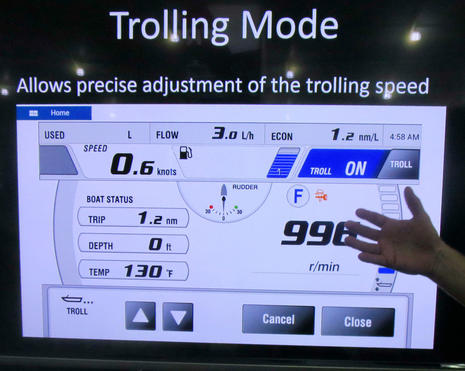 In Miami we also got a peek at the Yamaha gauge and control integration that will soon come as a software update to TZtouch2 displays. It's not quite the "first" Furuno expected, but it certainly looks like a complete integration close in style and function to Yamaha's own Helm Master display, and it can also emulate the Command Link LCD and Digital interfaces. All that's needed is a NMEA 2000 "interface unit" which is actually a new Yamaha gateway that has not been released yet (more info coming).
In Miami we also got a peek at the Yamaha gauge and control integration that will soon come as a software update to TZtouch2 displays. It's not quite the "first" Furuno expected, but it certainly looks like a complete integration close in style and function to Yamaha's own Helm Master display, and it can also emulate the Command Link LCD and Digital interfaces. All that's needed is a NMEA 2000 "interface unit" which is actually a new Yamaha gateway that has not been released yet (more info coming).
Furuno's Yamaha integration is not diminished by a similar Simrad announcement during the Miami show nor the fact that Yamaha simultaneously chose the Garmin 7-inch MFD as its new full-featured CL7 Command Link Plus and Helm Master display. (Garmin has not said if the Yamaha integration will also come to their regular MFDs, but that seems likely (and would be a lot like the Navico/Mercury VesselView relationship).)
DFF-3D multi modal sonar
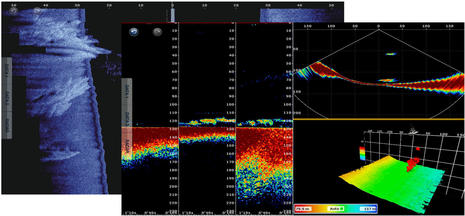 Last, but certainly not least, is the new DFF-3D multi-beam black box sonar for TZT and TZT2. Based on experience with their commercial WASSP muti-beam technology, Furuno developed four different modes for viewing the DFF-3D output, all of which can be used simultaneously.
Last, but certainly not least, is the new DFF-3D multi-beam black box sonar for TZT and TZT2. Based on experience with their commercial WASSP muti-beam technology, Furuno developed four different modes for viewing the DFF-3D output, all of which can be used simultaneously.
The side-scanned structure imagery visible on the background screen above is now familiar to many boaters because it's available from the other three big brands. And the 3D view at lower right -- in which the side scan info becomes a skin over a 3D model of the bottom with separate targets, often fish, highlighted in 3D underwater space -- is likewise becoming familiar (and popular). But that triple beam version of a traditional fishfinder view and what they call the cross section view are new to me, and both are potentially useful.
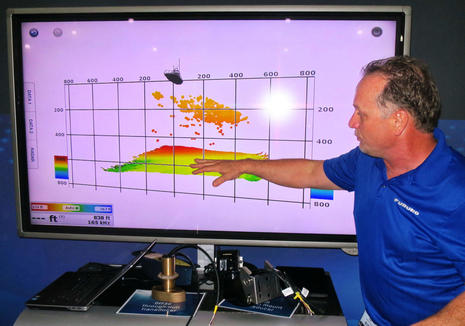 But what really seems different compared to the competition is the DFF-3D's higher power and lower frequency, a combination that seems to fit with Furuno's brawnier, bigger boat style. Note, for instance, that the 3D example Eric Kunz is discussing above shows bottom detail 600 feet deep in a swath about 800 feet wide. In fact, this sonar only sweeps 120 degrees port and starboard, not 180, and that makes sense away from shore where there's not much to see that's sideways and nearby.
But what really seems different compared to the competition is the DFF-3D's higher power and lower frequency, a combination that seems to fit with Furuno's brawnier, bigger boat style. Note, for instance, that the 3D example Eric Kunz is discussing above shows bottom detail 600 feet deep in a swath about 800 feet wide. In fact, this sonar only sweeps 120 degrees port and starboard, not 180, and that makes sense away from shore where there's not much to see that's sideways and nearby.
The DFF-3D retails at $2,095 and that's without one of the necessary multibeam transducers developed with Airmar. The closeup view of the transom mount model below says a lot, though perhaps mainly that this multimodal sonar is unlike anything else I know of in the recreational world. Furuno did not respond quickly to the rapid evolution of side scanning and 3D for fresh water and coastal fishing, but now they have, in their own way.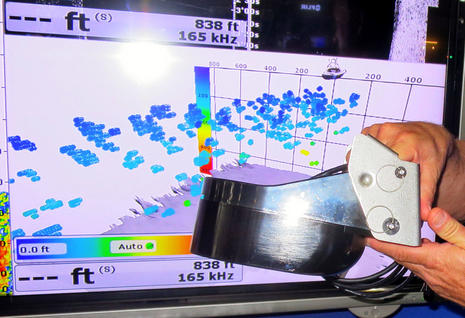

 Share
Share
Detail on Furuno X-Class radar ARPA and MARPA with Fast Target Tracking: They can automatically acquire up to 30 targets with a guard zone that can be variably set from 0.1 to 24 miles, or some of 30 maximum can be acquired anywhere manually.
Meanwhile, with Doppler assistance the NXT radome can get 40 ARPA targets anywhere within 3 NM, another 30 ARPA within a custom guard zone out to 24nm, plus 30 manual anywhere for 100 total.